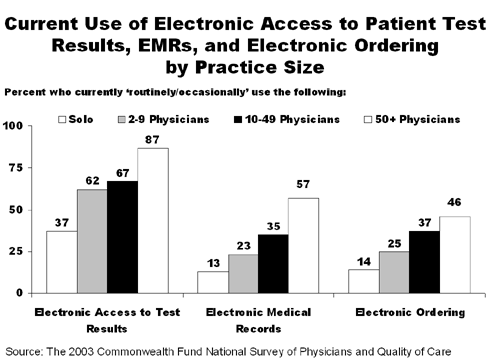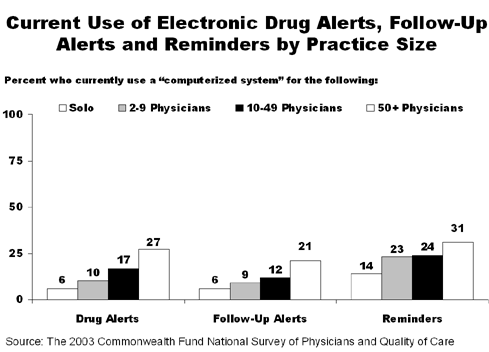New York City, December 7, 2004—Physicians are embracing electronic medical records (EMRs) and other health information technologies (IT) at a slower pace than expected due in large part to the high costs associated with implementing these practices, reports a new study in today's issue of Medscape General Medicine, the online, peer-reviewed primary source general medical journal that is published by Medscape. The findings make clear that while IT is viewed by many as the future of medicine, there are major stumbling blocks that will need to be removed to get physicians to routinely use it in their everyday practice. A survey of 1,837 physicians across the United States found that only a quarter practice in a "high tech" office where technology is used routinely to improve operational efficiency and clinical care. The survey, conducted by researchers at the Commonwealth Fund, found that the only information technology used routinely by physicians is electronic billing. There has been a much slower diffusion of technologies such as EMRs, computerized prescribing and order entry, clinical decision support systems (CDSS), and e-mail correspondence with physicians and patients, according to the survey.

Physicians who practice in large medical groups and who are salaried are more likely to adopt and use IT than those solo practitioners or those who practice in smaller settings. The size of a physician practice and mode of compensation are the two key variables that predict use of IT, the study, Information Technologies: When Will They Make It into Physicians' Black Bags?, found.
"There remains a technological divide between physicians depending on their practice environment and mode of compensation," says lead study author Anne-Marie Audet, MD, Assistant Vice President for Quality Improvement at the New York-based Commonwealth Fund. This is a major discrepancy that will need to be addressed, she says, since three quarters of U.S. physicians provide care in solo and small group practices.
Greater diffusion of IT in the health care setting is one of the top priorities of the current Administration, which last year appointed the first national IT coordinator. Audet and her co-authors warn, however, that it is unlikely that a robust IT infrastructure will be established in U.S. health care without stronger federal leadership and funding.
To spur wider adoption among physicians, policymakers will need to focus on ways to make IT tools accessible and affordable to all physicians, say the authors. For example, in the United Kingdom and Sweden, physicians who invest in EMRs receive government subsidies and it makes a difference. In the U.K., nearly 60 percent of physicians use IT; in Sweden, the rate is 90 percent.

The Commonwealth Fund survey, conducted between March and May 2003, looked at physician's self-reported use of, future plans for, and perceived barriers to adopting various health information technologies. Here are highlights of what they found:
- More than 75 percent of physicians use electronic billing routinely or occasionally but far fewer make use of IT to improve practice efficiency and quality or to communicate with other physicians or patients;
- Fifty nine percent of physicians report electronically accessing patients test results either routinely or occasionally;
- About 27 percent use an EMR routinely or occasionally; most often it is coupled with electronic access to lab results but less so to other decision aids, such as alerts to prevent drug ordering errors;
- One-quarter order tests, procedures, or drugs electronically, however, only 17 percent do it routinely;
- Fifty four percent send reminders to patients regarding routine check ups or preventive care but only 21 percent do this electronically.


